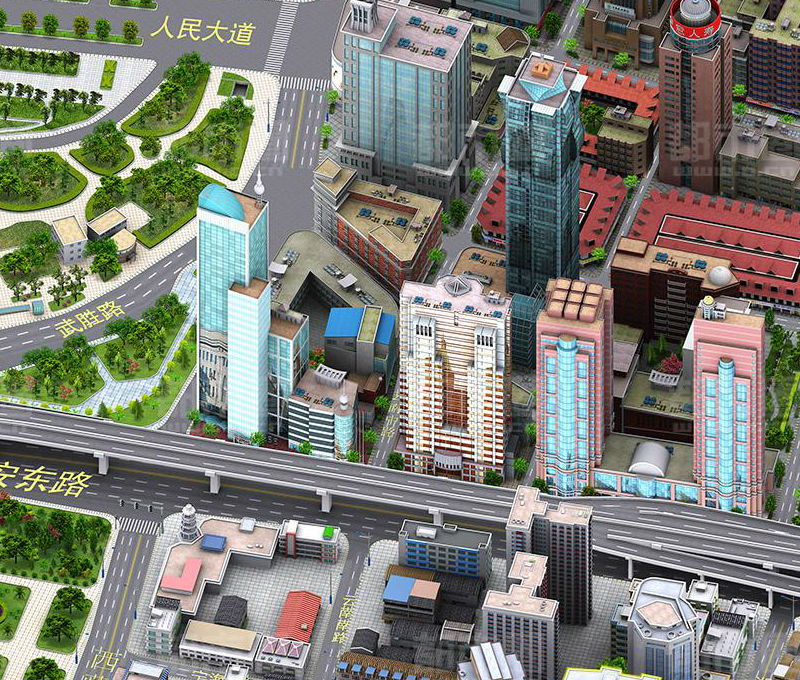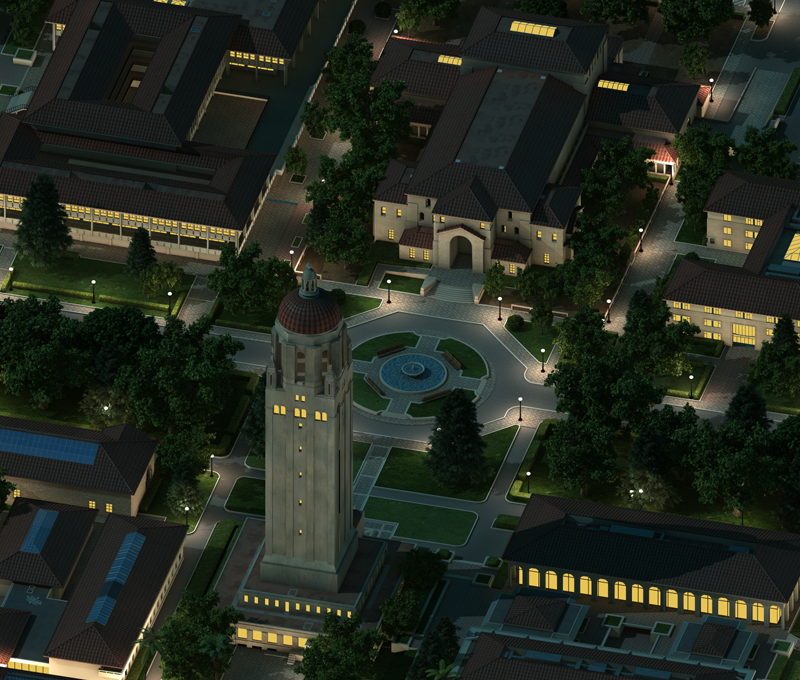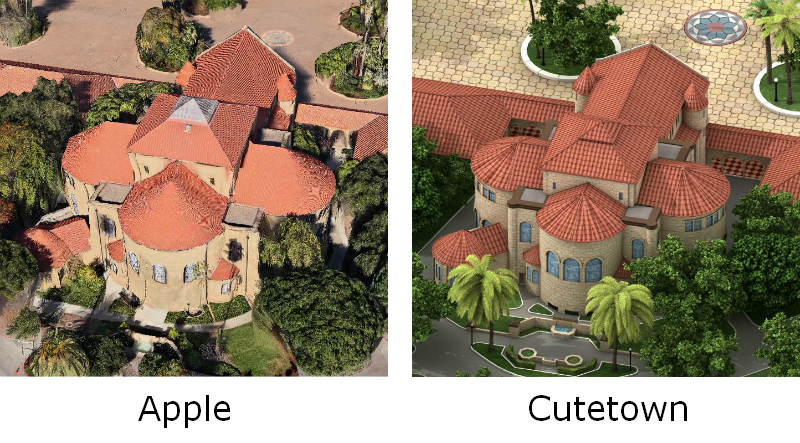DIY toy cartography or 3D maps
About a year and a half ago, a post was posted on Habré about unique maps of the Chinese search engine Baidu (for those who have not seen, here it is: http://habrahabr.ru/post/115107/ ). I was amazed at how painstakingly, in detail and beautifully these cards were made, so one day, together with a group of comrades, we decided to understand the process of creating Baidu-cards and make our own cards all over the world that would look just as cool. There are a lot of pictures under the cat, the disclosure of the secret of Baidu-like cards and what we got.

It is obvious to everyone that such things are something completely new for cartography. They are beautiful, they are interesting, they can be viewed for hours. They are understandable, in the end, because it is probably easier to find the building where you have an appointment if the map contains a detailed copy of it, and not a dull gray rectangle. Similar cards do not only Baidu; here are a few examples at random: Edushi ( shanghai.edushi.com ), the city of Kerch ( http://gorodkerch.com/map/ ), even Bing at some zoom levels shows no aerial photographs ( http://binged.it/O3F5Ez )
At first glance it is clear that creating a map of this level of detail requires enormous resources. The first thing that comes to mind is the work of millions of specially trained Chinese people who carefully, pixel by pixel, draw every building, tree and bench. We started from this point (not by looking for an extra million Chinese artists, but by drawing buildings using pixel art).
It soon became clear that the creation of even one house requires an incredible investment of time and effort. We were becoming more and more convinced that Baidu are 3d-cards, that they are rendered, and not pixel-by-pixel, by diligent Chinese guys. In fact, the fact that the maps were created in 3d says a lot: shading between nearby buildings, the same parts and objects that are located at different angles to the camera. After all, on the sitehttp://www.o.cn/ (manufacturer of cards for Baidu) we found a page that fully confirmed the guesses: http://gis.o.cn/en/3d-process.html . So, there was no doubt, Baidu is simply very high-quality rendered 3d-cards.
But even revealing the technology did not solve all the problems - the question remained open who and how would fill such cards. Okay, you don’t need to draw every object with your hands, you cannot redraw the same buildings from scratch, but only re-render ... Nevertheless, where to get so detailed, beautiful and detailed models of buildings?
Such questions and searches led us to the decision to make the map collaborative, that is, to create it together with users. Just imagine: users do not draw lines and rectangles in OpenStreetMap or Wikimapia, but beautiful, almost toy models of real existing houses!
Stanford University campus was chosen as a test site. To understand how cool maps can be produced, and to understand the process of their creation, we decided to first model the terrain on our own. While working on a university map, it was found out that it is absolutely possible to get a Baidu level picture
using v-ray: We can render not only a single view of the city from north to south, but all four of its views, or even more:
Changing the light in the scene, it’s easy to get a night view:
3d leaves a frenzied expanse for detail and nostrils - you can draw markings, lights, bushes, benches, other tasty things:
So, we simulated Stanford University for the test and proceeded to create a map of San Francisco, deciding to give everyone access to this process. Now the map is being assembled as follows: users in the 3d designer application (we chose Unity 3d) create house models, and on the server in the v-ray standalone package, beautiful pictures are rendered and sent to the shared map.
As a result, the full cycle of the application looks like this:
Now we are preparing to release a beta version of the application in the AppStore, with which users can create a map of San Francisco. We have learned to make pictures of excellent quality, with the smallest detail and exact correspondence to geographical location.
At the very beginning, we suggested that it would be very interesting for users to make such cards, but we never tested this assumption in practice. Today is the first time we are showing our work to a wide circle of people, and therefore we want to ask: would you be interested (yes, personally, habrayuzer) to participate in filling out such cards? And we have one more question: how / for what specifically would you be interested in using these cards / technology?
We are looking forward to any feedback!
You can see our maps here:
ps Anticipating holivars on the theme “fu, a card with only four views is garbage, nothing will ever replace real 3d”: just look at the picture. It depicts the same Stanford Church building. So it looks on fresh 3d-cards from Apple and on our map. We think the difference is obvious.

pps Yesterday we already tried to publish on Habré, but GAE billing failed and we got out of the quota.

Finding a solution (how did the Chinese do this?)
It is obvious to everyone that such things are something completely new for cartography. They are beautiful, they are interesting, they can be viewed for hours. They are understandable, in the end, because it is probably easier to find the building where you have an appointment if the map contains a detailed copy of it, and not a dull gray rectangle. Similar cards do not only Baidu; here are a few examples at random: Edushi ( shanghai.edushi.com ), the city of Kerch ( http://gorodkerch.com/map/ ), even Bing at some zoom levels shows no aerial photographs ( http://binged.it/O3F5Ez )
At first glance it is clear that creating a map of this level of detail requires enormous resources. The first thing that comes to mind is the work of millions of specially trained Chinese people who carefully, pixel by pixel, draw every building, tree and bench. We started from this point (not by looking for an extra million Chinese artists, but by drawing buildings using pixel art).
It soon became clear that the creation of even one house requires an incredible investment of time and effort. We were becoming more and more convinced that Baidu are 3d-cards, that they are rendered, and not pixel-by-pixel, by diligent Chinese guys. In fact, the fact that the maps were created in 3d says a lot: shading between nearby buildings, the same parts and objects that are located at different angles to the camera. After all, on the sitehttp://www.o.cn/ (manufacturer of cards for Baidu) we found a page that fully confirmed the guesses: http://gis.o.cn/en/3d-process.html . So, there was no doubt, Baidu is simply very high-quality rendered 3d-cards.
Our experiments
But even revealing the technology did not solve all the problems - the question remained open who and how would fill such cards. Okay, you don’t need to draw every object with your hands, you cannot redraw the same buildings from scratch, but only re-render ... Nevertheless, where to get so detailed, beautiful and detailed models of buildings?
Such questions and searches led us to the decision to make the map collaborative, that is, to create it together with users. Just imagine: users do not draw lines and rectangles in OpenStreetMap or Wikimapia, but beautiful, almost toy models of real existing houses!
Stanford University campus was chosen as a test site. To understand how cool maps can be produced, and to understand the process of their creation, we decided to first model the terrain on our own. While working on a university map, it was found out that it is absolutely possible to get a Baidu level picture

using v-ray: We can render not only a single view of the city from north to south, but all four of its views, or even more:

Changing the light in the scene, it’s easy to get a night view:

3d leaves a frenzied expanse for detail and nostrils - you can draw markings, lights, bushes, benches, other tasty things:

So, we simulated Stanford University for the test and proceeded to create a map of San Francisco, deciding to give everyone access to this process. Now the map is being assembled as follows: users in the 3d designer application (we chose Unity 3d) create house models, and on the server in the v-ray standalone package, beautiful pictures are rendered and sent to the shared map.
As a result, the full cycle of the application looks like this:
- The user draws the perimeter of the house on top of satellite maps, as in OSM. We build a closed loop and transfer it to Unity, and also remember the location of the house on the map.
- In the designer, the user creates a model of the house: textures it, places windows, doors, bay windows, cornices, sets the shape of the roof - in a word, turns a rectangle into a highly detailed model. When the model is ready, it is sent to the card. Unity exports the scene to obj and sends it to the server.
- The server accepts obj, calculates the position of the house on the map, places it in the scene with a map of the city where the light is already configured and v-ray materials are created. Then the server calculates which map tiles have changed due to the setting of the house, renders it in tiles, renders SVG for highlights and sends it all to the web server.
Conclusion
Now we are preparing to release a beta version of the application in the AppStore, with which users can create a map of San Francisco. We have learned to make pictures of excellent quality, with the smallest detail and exact correspondence to geographical location.
At the very beginning, we suggested that it would be very interesting for users to make such cards, but we never tested this assumption in practice. Today is the first time we are showing our work to a wide circle of people, and therefore we want to ask: would you be interested (yes, personally, habrayuzer) to participate in filling out such cards? And we have one more question: how / for what specifically would you be interested in using these cards / technology?
We are looking forward to any feedback!
You can see our maps here:
- cutetown.net - site with a map of Stanford University
- cutetown.net/hires - highres. On it you can see all the small details such as bicycle parking lots, tables in cafes, markings, etc.
- cutetown.net/sf - map of San Francisco for which the application is being prepared
ps Anticipating holivars on the theme “fu, a card with only four views is garbage, nothing will ever replace real 3d”: just look at the picture. It depicts the same Stanford Church building. So it looks on fresh 3d-cards from Apple and on our map. We think the difference is obvious.

pps Yesterday we already tried to publish on Habré, but GAE billing failed and we got out of the quota.
